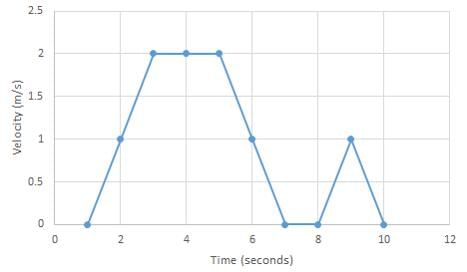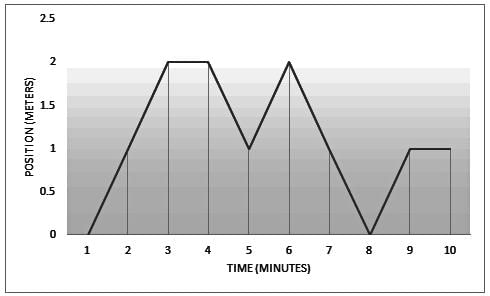Test: Translational Motion and Calculations - 2 - MCAT MCQ
10 Questions MCQ Test - Test: Translational Motion and Calculations - 2
An ambulance is currently traveling at 15m/s, and is accelerating with a constant acceleration of 5 m/s2. The ambulance is attempting to pass a car which is moving at a constant velocity of 30m/s. How far must the ambulance travel until it matches the car’s velocity?
The velocity of a toy car is plotted on the following graph. What is the total distance travelled by the toy?


A Boeing 747 aircraft has a landing speed of 72 m/s, and upon landing it is able to come to a stop in 2,000 m. Assuming constant deceleration, how long would it take for a Boeing 747 to come to a full stop?
A Ferrari Enzo is able to reach a speed of 134 miles per hour (60 meter/sec) from 0mph in 11 seconds. Assuming constant acceleration, how far would the Enzo travel in this amount of time?
Using our initial formula, d = Δt (va), d = 11 sec x 30 m/s or d = 330 m

Which of the following is a true statement concerning speed, velocity, and acceleration?
Top fuel dragster cars can accelerate from rest down a quarter mile track (400 meters) in under 4 seconds. Assuming constant acceleration, what would the acceleration of a dragster be if it sped down a track in exactly 4 seconds?
In 1997, the Thrust SSC, a turbofan powered vehicle, achieved the land speed world record of 760.34 mph (1,223.65 km/h) and became the first car to break the sound barrier. If it took 1 minute for the Thrust SSC to reach its top speed, what was the average acceleration during that time?
To reach the orbital altitude of Earth, a space shuttle must accelerate from zero to 8,000 meters per second (~18,000 miles per hour) in eight and a half minutes. What would the minimum average acceleration of the shuttle have to be in order to achieve this?
Aroldis Chapman holds the world record for fastest baseball pitch at 105.1 mph (169 km/h). The distance from the pitcher’s mound to home plate is approximately 60 feet (~18 meters). Assuming constant velocity, how much time would a batter have to react to Chapman’s world record pitch?














